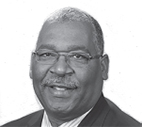
DANIEL McCLOUD
Eight minutes and 46 seconds was the time it took for Dereck Chauvin and his fellow officers to murder George Floyd. But it has been 401 years since Africans were kidnapped and brought to this country as slaves. From 1619 to 1865, the institution of slavery thrived, as well as the persecution of African Americans. While the 13th Amendment was supposed to end slavery and subsequent abuse, Black Codes, Jim Crow laws, and lynching were used to maintain a hierarchy of White Supremacy. According to the Tuskegee Institute, at least 4,742 people were reported lynched in the United States between 1882 and 1968. In nearly all of the cases, those responsible were not punished. I should note that many Whites were also lynched, primarily for helping Blacks. I must also point out that not all lynchings were reported.
Again, we’ve had over 400 years to address these issues, and yet they remain. Should we be surprised that it has taken this long for America to look itself in the mirror? After all, it’s 2020, and Congress couldn’t even reach unanimous consent on the passing of anti-lynching legislation. Lynching!
Eight minutes and 46 seconds. Why you might ask would a police officer who is sworn to protect and serve, murder an individual in broad daylight, while being filmed by onlookers who begged him to stop? The answer is simple; the officer has a privilege that few people will ever experience. He and his fellow officers knew that he was shielded by a system of institutionalized racism that has allowed and encouraged his behavior for hundreds of years. He never once considered the consequences of his actions. To understand this hegemony, we must first examine the destructive relationship between law enforcement and Blacks in this country.
For many African Americans, the frustration begins when the very thought of police brutality is dismissed. However, when tracing the root of this lawless behavior, one must examine the origins of the relationship between the justice system and Blacks in this country. This relationship originated in the South with the creation of the “Slave Patrols” or “Slave Hunters.” Research tells us that the first Slave Patrols began in the Carolina region of the United States. These Slave Patrols had three primary functions: (1) To return runaway slaves to their owners; (2) To terrorize slaves as a deterrent to escape and revolt; and (3) To discipline slaves if they violated plantation rules (Potter, 2013).
In addition to these Slave Patrols there also existed White Supremacist terrorist groups such as the Ku Klux Klan, the Knights of the White Camellia, the White League and the Red Shirts (1875). For many African Americans, these terrorist groups were synonymous with law enforcement, as many of the law enforcement officials belonged to these groups. Black’s disdain for law enforcement was magnified by the fact that little was ever done to those who antagonized, tortured and murdered them. Let’s be clear; I’m not saying that all law enforcement officials are corrupt. I am saying that to dismiss the notion of a system of corruption designed to brutalize and murder Blacks is merely naive.
Eight minutes and 46 seconds. So where do we go from here? Will real change occur this time? People say that America is at a crossroads. Perhaps America is actually standing on the edge of a cliff. Teetering on the brink, with 8 minutes and 46 seconds to pull itself to safety. Reeling under the weight of a global pandemic and the pandemic of hate. As scientists work to find a cure for the former, what can be done about the latter? In developing a cure for the disease of racism, we must first acknowledge that there is a problem. Next, we must empathize with the victims of this disease and then work together to find a cure. Many people feel that they are absent from the disease of racism. Perhaps they are only asymptomatic yet still carry the virus. Racism has many symptoms, including implicit bias, racial stereotyping and apathy. We must own the history of this country and educate the youth on the wrongs that have been done. In all its forms, Black history is American history, and therefore should not be relegated to a month.
As you sway back and forth on the edge of the cliff, for 8 minutes and 46 seconds, consider what you can do. This must include individual conscious efforts to do better in deeds, not just words. As you continue to sway, contemplate your place in history, consider that as each second ticks down, you will soon breathe your last breath. How do you want to be remembered?

Recent Comments